
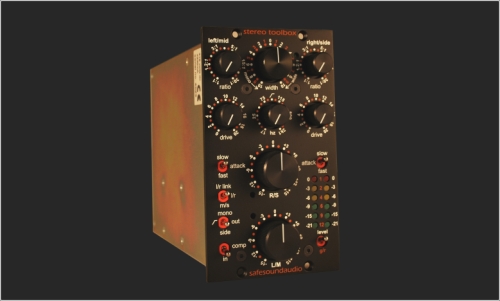
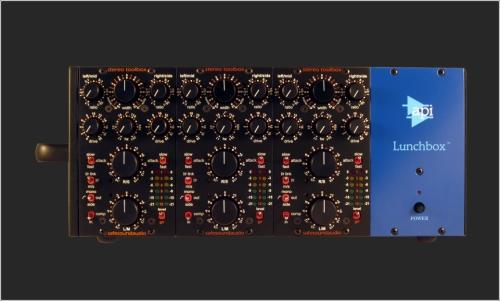
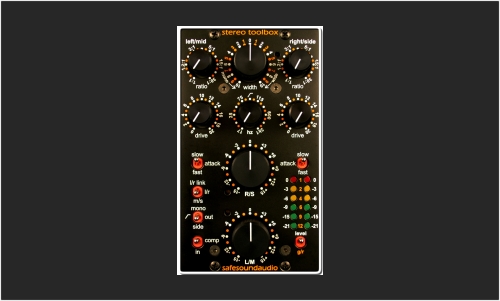
The ultimate 500 Series stereo bus compressor that does so much more than any of its competitors. Dual mono! Stereo linked! Mid/Side compression! Stereo Width control! Sweepable Side-chain filter! Cinemag Steel Core Output Transformers!
This is the flexible toolbox of 500 Series compressors that can track when required to, fantastic across the 2-buss, and all the way into mixdown and mastering duties. Perfect for those needing a high end compressor for all stages in the recording and production process.
Check out the great features below.

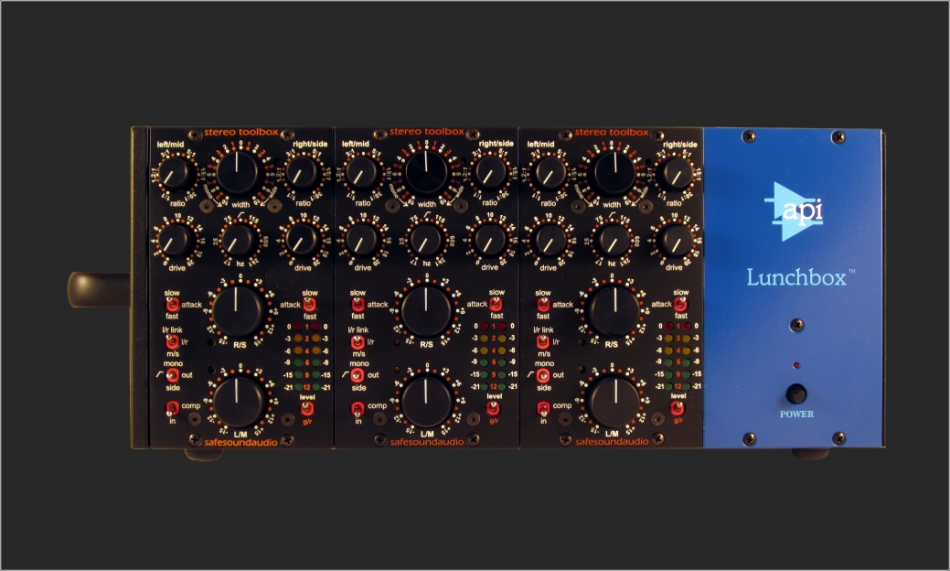

Some of the reviews below include extensive sound samples which are pre-loaded into your browser so you can flip from sample to sample without having to navigate away from the page. So loading may take a few moments longer than usual.
Frank Perri reviews the Stereo Toolbox and compares against the Xpressor 500 and the Obsidian 500
Frank Perri is a keyboardist and arranger with a range of live performance, recording and arranging credits which reads like a who's who of 'been there and done it!' If we mention that Frank has arranged for and led the Duke Ellington Orchestra, has guest conducted the Brooklyn Symphony Orchestra, is musical director of 'Break The Floor Productions', one of the world's preeminent dance entertainment companies, AND has appeared in the new US TV show "Pan Am" on ABC Television, you can see we're not exaggerating. Oh yes we forgot to mention; Frank is an amazing keyboard player!
Frank takes product reviews to a whole new level as well, and he was kind enough to put a Safe Sound Stereo Toolbox through it's paces and compare and contrast against the Xpressor 500 and the Obsidian 500. There are lots and lots (and lots) of sound samples so switch on your monitors and sit back and enjoy!
"Thanks to the generosity of Warren at ZenPro, I was sent a demo unit of the Stereo Toolbox to play with for a few days so I figured the least I could do for the privilege was come back here and post my thoughts. And make no mistake, it is a privilege to be sent a piece of expensive, handmade gear to test on the basis of a gentleman's agreement over the telephone.
I spent the weekend running tracks through it and shooting it out against the two stereo compressors I do own - the Elysia Xpressor and the Dramastic Audio Obsidian. What are my thoughts? Keep reading!
As you can see in photo, the Stereo Toolbox is compressing. The meter uses a dot to indicate compression, lighting more then one dot when the value falls in between the two indicated values. For example, if there's 5 db of reduction happening, then the dots for 4 and 6 will light. It actually works pretty good and I had no problem getting an idea of how much compression was happening at any one time.
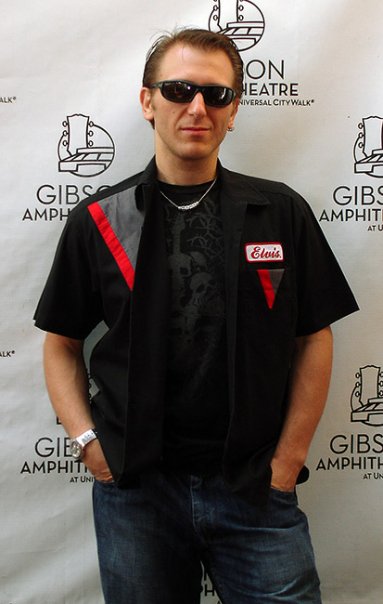

The meters are a tiny bit sluggish but in a good way - more towards acting like a VU meter then a peak meter, meaning that for both the gain reduction and the output level, the meters don't dance around in some manic motion lighting tons of LEDs. It's actually pretty easy to dial in compression. As far as the output meter goes, it was easy to put the comp in bypass, look at what the meter was peaking at and then bring the comp back in and dial up the make-up gain. I was usually within plus or minus one or two clicks of the make up gain knob to matching the output. It works really well and feels intuitive. Since the metering doesn't go decibel by decibel but skips, for example -9 to -6 to -3, this might be the reason that the meters aren't at all peaky. Whatever it is, it works very well.
It uses a dot for gain reduction, but fully lights up the LEDs for output metering. It's a very smart system meaning at a glance you know exactly what mode you're in.
As far as the feel of the pots, I'm happy to report that they are stepped! Not sure of the amount...41 maybe? But I'm guessing. It's lots of little steps like the Xpressor or the ART Pro VLA II. In fact, with the knobs, it feels EXACTLY like it! If I closed my eyes and spun the knobs, I'd never know which is which.
But unlike the Xpressor, which is recallable but difficult as the legends around the dial are sporadic; 3 clicks between ratio 1.6 and 2.0, 6 clicks between 2.0 and 5.0, 4 clicks between 5.0 and 15, making recall difficult and the ART with almost no legends making accurate recall almost impossible; instead the graphics on the Toolbox are extremely well calibrated with the steps. So there's a ton of steps on the pots, but it works with those little dots around each knob. It's calibrated so that there's a step on a dot and a step in between each dot. Factor in the alternating white and orange dots and the abundance of landmarks and you have a system where you have a range of steps that almost approach variable sweep pots but able to recall rather quickly and accurately. I was very impressed with the thought that went into this as it's obvious it was designed by someone who uses gear.
Very thoughtfully, when in L/R linked mode one set of controls control both sides - even make up gain. Oh, how I love when they do that! But with the stepped pots and landmarks it makes it easy to match the left and right sides completely if you want to try compressing a stereo source with unlinked sides.
Other standouts are the impressive sidechain filter, able to sweep from a very low 17 hz all the way up to an impressive 2100 kHz! Besting even my previously impressive Xpressor with its sidechain that goes to 1000 kHz."
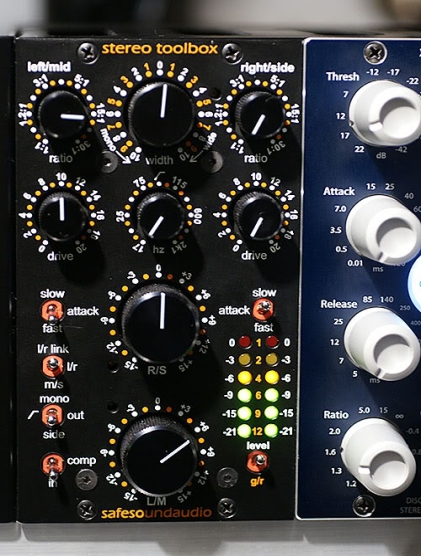
"Personally I found this to be a huge benefit. With just two attack speeds and only auto release, being able to sweep the sidechain that high led to some interesting compression effects to loosen things up a bit, for example being able to compress drums excluding pretty much the kick, toms and most of the snare from the compression. This sidechain can also be inserted into the side audio path when doing mid/side compression.
Another standout was the interesting ratio knob. It's a (I believe but correct me if I'm wrong) log tapered type stepped pot, meaning that as you go around the pot, the values increase exponentially rather then proceed in an even pattern. The ratio knob starts at 1.1 and goes to 30. It starts out with rougly 9 steps between 1.1 and 1.2! I know there are some people who have extreme hearing for the subtleties of compression. For those people, this level of control should make them happy. It starts to move a bit quickly from there with 7 steps between 1.2 and 3, 9 steps between 3 and 5, 8 steps between 5 and 15 and 7 steps between 15 and 30.
This is a great system as it gives you less choices between high ratios, say 10 to 30 where you don't really need it, but a lot of choices in the lower ratios so you can finesse things. I found it to be a great balance that worked and I never found myself fighting the values or wishing for an extra step between two ratios.
The toggle switches felt great. There's two types - ones with two selections and ones with three. The ones with three feel solid and the middle selection is firm. You won't miss it by mistake. It was kind of fun to flip the toggles for bypass and for output/gain reduction."


"Another interesting feature was the ability to push the transformers for more color. It's obvious that Safe Sound has been in this territory before, giving you control over your choice of transformers in the Dynamics toolbox or using an electronically balanced output if you want. I'm not big on transformer coloration so I was very happy that I had the choice to run the transformers cleaner. Unfortunately the toggle for this is hidden away inside the unit so you have to make the choice ahead of time how you want the compressor to run before you install it. If you want to change it, you have to pull the compressor out - not something I want to do often with my 500 modules. I have a hard enough time just lining up the cards to go in the slots the first time. I set my toggle switch to clean, so the examples I'm going to provide are the comp running in clean mode. Even though I don't like coloration, I'd be lying if I didn't wonder what more colored would have sounded like on sources I thought were overly bright like vocals or acoustic guitar.
In clean mode, this comp has a really clean, extended sound. I felt like I could hear transients cleanly and it's got a clean, bright sound, which I love since most comps dull the material when compressing."
"The most unique standout, obviously is the width knob which works in Mid/Side or Stereo mode. This was an interesting feature that I had fun playing with but it can quickly get out of hand if I didn't stop and keep listening to what I was doing! More on that later.
Everything's a trade-off and there's not much real estate on a 500 module. SafeSound made some choices such as no release choices and consigning attack to a toggle with two choices in order to make room for more creative options. It's a good choice as this comp isn't limited by the attack or release choices and instead we gained a sidechain knob, a width knob and two sets of controls so that this comp is unlinkable and able to be used as two mono compressors. There aren't many stereo comps out there to begin with for the 500 series and this feature doesn't appear on any of them, if I'm not mistaken. There's the Obsidian, the Dual Vandergraph, the Xpressor, the Stereo ToolBox and the AltaModa Hippo, which allows you to unlink the sides but still there's no independent control of each side. So this might be another first for a 500 series stereo compressor. Dual mono to use independently as two separate linkable mono tracking/mixing comps without having to buy two single 500 series comps and solder pin 6!
Right off the bat, my initial impressions were that this comp sounded great and I don't ever remember getting a bad result. I didn't feel overly limited by the two attack speeds and often if one speed didn't work for me, the other one did. The auto release was impressive and followed everything I threw at it, never missing a beat. The knobs want to be twisted and I found myself pushing up ratios, the sidechain and the make-up knob constantly. This comp, to me had a confident sound and leveled stuff easily. There's plenty of makeup gain and I had no problem making up levels, even when I smashed things. That just made me want to compress more. In practice, I rarely went above 9db of make up gain as any higher then that, any my converters would start clipping so I never really got to push it to 15!
The gain reduction meter only goes to 12, so if you do more then 12 db of reduction it just lights solid at the 12 db line so you know. At first I thought this would be limiting but in practice I didn't have a problem with it. By the time I went over 12 db I could easily hear how badly I was destroying my source or not, and at that point I was using my ears anyway.
I know I can babble a lot and most of you are asking... How does it sound already?!"
"I also think it's important to say before we proceed -
As always Try before you buy! These are my experiences and how I hear things. You may not agree with what I say or my choices! I hope what I post here will push you to try this compressor. Please, don't make a decision whether or not to buy this compressor simply from what I write here. I have done my best to level match my samples where possible but feel free to download the samples and play with them in your daw. Level match them on your system! Some of my examples, I also include the uncompressed track so you can hear how hard or soft I was hitting a track. Feel free to download the uncompressed tracks to run through your comps to compare your results!
As always, my samples are copyright myself, except for the samples from the song "Rockstar" which are copyright my talented vocalist friend, Gwen Mann.
All my samples were recorded and output using my Mytek 8x192 converter (also purchased from ZenPro - Thanks Warren!) and I used Mogami XLR cables, except the instrument cables which were Canare. I know some of you care about that stuff. None of my samples have been EQ'ed or Auto-tuned or anything. Straight into the converter and the comps so I could hear what the comps are doing to the original source as much as possible. This is as raw as it gets going through the compressors."
And now on to it!
Acoustic Guitar
"Here's a plucky, strummed acoustic guitar with a lot of dynamics. Some strums are hit hard. If I remember correctly, I used a ratio of 4:1 and the compression was between 6 and 9db for the compressors, give and take.
I included a sample with the toolbox using the fast speed (1 ms) and the slow (10ms) so you can hear how each affected the transients and body.
The names of the Compressors are in the titles. The file, "Aco Gtr" is just the uncompressed track.
My thoughts:
This is the kind of stuff the Xpressor was made for. With it's ultra fast attack speed (.01 ms!), auto fast mode, Gain reduction limiter and mix knob it feels like it was built to wrestle transient material like percussion or acoustic guitars. I put it in warm mode, which rolled off the top and added a bump to the body which I felt really helped with the sound of the guitar. My favorite in this example.
The toolbox performed fine and I felt like if I didn't have the Xpressor, this would have definitely been my second choice, except I either would have rolled off the top or used a de-esser on the guitar to kill some of the harshness from the guitar sound. If I pushed it into higher ratios, I could get the transients to flatten even more.
The Obsidian was my least favorite. While it still sounds good, I felt that the "shimmer" that the Obsidian adds to things it compresses actually made the "glassiness" of the acoustic guitar worse and brought out the pluckyness of the picking more."



VOX
"Vocals I hit also with a ratio of 4:1, I believe doing about 6 to 9 db of reduction.
Vocals is something I felt like the Stereo toolbox excelled at. No matter how hard I hit vocals, they always sounded great. I used the fast attack speed (1 ms) to grab the vocals and the auto release took care of the rest. Even auto release on my Obsidian, which I think is fantastic and I love on many sources, always seems to choke on vocals and once in a while will pump. The Stereo toolbox had a great sound for vocals and I felt here, the open top end really benefited the sound of the vocals. This comp can abuse vocals and they always sound good.
My second favorite was the Obsidian. It's not my favorite vocal compressor so I tend not to use it often for that, but here I thought it performed decent - almost as good as the stereo toolbox except I felt that it wasn't as open on the top as toolbox was. I definitely preferred the Toolbox for vocals.
My least favorite was the Xpressor which I felt gave the vocals a "bloated" feeling. Maybe it's a bit too mid-forward for vocals."
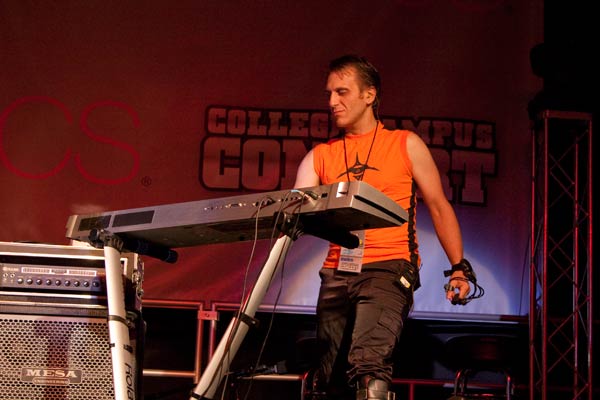


Plucky Synth Bass
"This is a plucky bass line from a manic J-pop tune I was called to write for an anime-based videogame. I went for heavy squash on these - using a ratio of 15 I think for the toolbox, Skull for the Obsidian, and Infinity for the Xpressor. I was doing about 9 to 12db of reduction.
Again - the Stereo Toolbox takes the cake here. It just had a fantastic way of dealing with the transients. I set the attack to fast and hit it hard. It really pinned the bass down without ever closing it it. It's most noticeable on the attacks of the little arpeggio at the 6 second mark. It handles those transients great and also added a nice weight to the bottom. I can feel it hitting me in the stomach.
The Xpressor was my second choice. It had a good sound, and warm mode also added some weight to the bottom though not as much as the Toolbox. I wasn't thrilled with how it handled the transients though for that little arpeggio at 6 seconds in and I couldn't seem to get anything better then what I'm presenting here. Still a good result, though.
The Obsidian I feel doesn't cut it on synthy basses. The Obsidian seems to have a lot of problems handling synth basses of all kinds. If you listen closely to the bottom, it gets farty and honky on the attacks. By the time I dialed the attack back to fix that, I was at 10ms. Not what I was looking for. This doesn't happen with program material, but then again compressing 3db at a ratio of 2 is a lot different then squashing a synth bass for 12db on max ratio. But the Obsidian consistently chokes with this when it's a synth bass."


Drum Madness!
"The Toolbox goes great with drums! It's fun to twist the sidechain and play with the attack. The auto-release follows drums with no problem and I got lots of great results from smacky to punchy to sucked away!
For the below examples, I decided to forgo any types of comparisons since drum bus compressors are done to death. Most people know what SSL sounds like, API, etc. I include the un-compressed drum track so you can play with your compressor and instead have a bunch of different sounds I got with the toolbox.
Each file says either Attack slow or fast and what the ratio was. If High Pass was used, it says HPF and the High pass was set at about 600 (3 o clock).
For ratios of 2 to 3:1, I peaked the snare somewhere at 6db of reduction. For ratios of 10 the snare peaked between 9 and 12 of reduction.
Drum track was played on V-Drums because I love V-Drums. And I'm not ashamed to admit it.
Good stuff."



Solo Piano
"I hit record and just noodled some solo piano stuff. For you sharp eared people who grew up in America - all the way at the end you catch me quoting the little jingle for the old Channel 4 NBC "The More You Know" public service announcement for kids on Saturdays. Because it's true.
Slow attacks all 'round and a ratio of 4:1. Piano sound is the Yamaha C7 from my Nord Stage EX.
Still my favorite piano compressor, the Obsidian reigns here. It has a great open, slightly scooped sound to my ears that just sits well with piano. With a long attack and low ratio, the piano just gets leveled nicely and sounds great.
BUT - This is strictly for Left / Right compression. I wasn't ready for the width knob on the Toolbox!
The toolbox, sounds a tiny bit too mid-forward to my ears for the type of piano sound I like. But when I dialed the width knob to 3 wide (about 2 o clock) the piano sound completely changed! By widening, the mids completely opened up and the piano just sounded larger then life! I really loved the sound of the piano widened slightly. Along with the bright top of the toolbox and it just made the piano sound great.
The Xpressor, I felt was too boxy in the mids for solo piano. I had a hard time dialing in a good attack, but that might just be my inexperience.
The Obsidian is still my favorite straight-forward piano compressor but if I was doing a solo piano album, I'd have to give serious thought to recording it instead with the toolbox compressing with the width on 3. Just gorgeous to my ears."


Slow Program Material
"Here's a piece I threw together quickly just to test compressors. I tried to include a mix of stuff - obnoxious solo synth, sweeping pads, gurgling synth bass and an "attacky" piano. It's only about 30 seconds but it gets the job done.
I showed my fiancée and said, "I wrote that in a few minutes. Cool, huh?"
She said, "It sounds like all the licks you practice when you warm up for session work, but just shoved in one short song."
Leave it to a woman to cut you down to size.
Here's where I hit a slight wall with the toolbox. I felt like the slow time of 10ms still wasn't enough for me on program material. I could hear it just grabbing the piano a bit more then I wanted it to. To me, it's most obvious in the quarter note piano chord walkup at 13 seconds. If you compare those 4 piano hits to the Obsidian one, I feel like the piano sounds a bit more open since it's not being grabbed as fast in the Obsidian one. Obviously I preferred the Obsidian one here.
For the Toolbox, I used a ratio of what I think is 2:1 (10 o clock), slow attack and about 2 db of reduction.
For the Obsidian, I used an attack of 30ms, a ratio of 2:1, auto release and about 2 db of reduction.
I don't remember why I didn't test the Xpressor...maybe I forgot...I had a tooth pulled Friday morning and I was on Vicodin all weekend."



Gurgly Synth Bass
"Here's the Gurgly Synth bass from the previous post for the little Compressor test piece I wrote. I was curious how the Toolbox would handle this since the Obsidian gave me problems with this. Because it's a synth bass.
Ratio of about 10:1 I believe with 9db of reduction more or less - attempting to level the gurgles.
The Xpressor handed this with no problem. Not as fat as the toolbox result but totally usable. Kick in the warm button and we're ready to go!
The toolbox excelled here again on bass material. The auto-release followed the synth with no problem. Fast attack. Great result and it added a little bottom to it as well. My favorite for this sound.
The Obsidian just doesn't get along with synth basses. I had to dial back the attack to get a usable result. A lot of nasty resonances and farting coming from the bottom of the Obsidian here."


Program Material Mid Tempo
"This is part of a piece I called "Impressions". I have a friend who's a phenomenal artist. Paints with oils. But most of his material is on the dark, exaggerated side. Depressed people with long, gangly limbs. Eerie stuff. He also paints the storyboards for the Blue Man Group shows - go figure.
Anyway, he asked me to throw together something dystopian-like for him. Kinda Blade-Runnerish. That sorta thing. He wanted it to use as a soundtrack to paint to for inspiration. So here's a clip from that piece I made for him. It's synthy and open and some electronic drums kick in so you can hear the toolbox on some harder material.
I thought I got close to the mark. My friend loved it. My fiancée said instead of dystopia it sounded like the underscore for a car commercial. She has a way of not mixing words...
I also did a mix using the mid/side mode. It's listed as "wide" in the below songs. Mid/Side mixing is definitely something new for me and was tough to do. I have a hard enough time hearing the difference between hitting a track with a ratio of 4:1 and a ratio of 8:1, much less compressing the middle of the sound field something different then the sides!

Frank appearing on the televsion show, "Pan-Am" acompanying Karine Vanasse at the piano.
Never the less, I tried my best. For the "wide" mix, I compressed the sides at a ratio of 2:1 with a reduction of 1-2db and the middle I compressed the middle at a ratio of 4:1 for 2-4 db of reduction. I DID NOT use the width knob, but you can plainly hear that the "wide" mix sounds much wider then a standard L/R mix. So maybe there is something to mixing songs with two different amounts going on at once! I was impressed.
The Xpressor has an interesting sound. It's transformerless and fast so it can sound very open at times. It definitely opened the mix a bit here and sounded good. Dialing the Sidechain up for the drums helped. I'd have no problem with this mix being compressed by the Xpressor.
Again, I feel like the 10ms slow time of the Toolbox wasn't enough. To me, I can hear it most easily in the slightly rounded off kick in the part where the drums come in and how the snare is tucked a little bit more in the back. No matter how high I dialed the sidechain, I couldn't get the kick to come out more. Still a solid performance, though.
The Wide mix is my mid-side mix. I think it's wonderfully open and wide and it was interesting to keep lowing the mid and side volumes back and forth so I could hear what I was doing, compression-wise. I'd love to explore this way of compressing the masterbus a bit more.
As for the Obsidian, this is where it shines. On this one, the kick was hitting me in the chest a little harder. And I was only using a sidechain of 125 Hz I think.
It's most obvious with my sub-woofer on, but it's there. But that's just to illustrate how subtle the differences are between these comps. They're all solid performers - it really is just a game of inches at this point."


Final Thoughts
"Well, here we are at the end. What have we learned? I have too much time on my hands and I need to de-compress! ha!
Seriously -
I know it's been said before that there's no one do-it-all compressor and it's been proven to me in all this testing. To me, these are three different comps. One is a straight forward, old-style bus compressor (the Obsidian) built to mainly perform that job. One is a super-tweaky compressor with a number of different features that can get you in or out of trouble if you don't pay attention (the Xpressor) and one is trying to bring a whole new take on compression telling me, "that attack and release stuff is old news, kid...lemme show you what mid and side is all about!" (The Stereo ToolBox).
I really had a lot of fun with the Toolbox. I'm really being honest when I say it was hard to get a bad sound out of it. It responds really well and you know within seconds if you're heading in the right direction or not.
For the most part, the two choices of attack are really chosen well and I said much earlier that when one speed didn't work for me, the other usually did.
Not having to worry about release just lets me focus on the sound I'm getting and flipping back and forth between the two speeds is easy and you can hear the effect fast. It's a lot more fun then trying to hear the difference between .1 and .3 attack speeds and then trying to find a good release speed, which for me can take a lot longer then I want!
I found myself setting the comp in familiar territory to start, but then tweaking right away if I didn't hear what I want. And not always tweaking the way I expected! For example, I might try a ratio of 3 on the vocals and 14 on the drive. And if I don't hear enough compression, rather then up the drive, I would start clicking up the ratio and seeing what happens. It's really quick and easy to get a good result which helps the creativity. I never felt tied down trying to figure out what worked. I usually had something good in seconds. Slow speed not working? Try fast. Good. Raise the drive - ok 6db compression. Still doesn't sound right...up the ratio. Ok, a little too tight? Let's drop the sidechain in. Bam! Perfect! 15 seconds!
The sound itself was great. Bright and open on top.
My personal thoughts are that this is a real workhorse comp. Even looking back at my material in all the other posts - when it wasn't my favorite, it never performed badly. Even with just two attack speeds and auto release I was able to dial up a big number of different drum bus sounds. It's my favorite on all bass material and equally impressive on vocals. The width knob blew my mind on the piano stuff.
It's a professional comp and as you can see it can hold its own. I also feel that it's a great comp for less experienced who just want to get a good sound but aren't confident enough with setting attack and release times. I also feel like it's a great "bang-for-the-buck" compressor against other similar, results driven compressors like the UBK fatso, where the user is pushed to get a result and not worry about attack and release times. I also feel like it's a great comp for the experienced who don't feel like wasting time. You can dial in a good sound so quickly on this that it was nice for a change not to worry so much about attack or release. I'd also trust it completely for tracking. It's so easy to set up I can't imagine screwing up a tracking session."
Now the Ugly!
"Well, I had a lot of complimentary things to say but there's obviously some slight cons as well.
First, the ability to change the coloration of the transformers is such a great option in a 500 series module. It would be great to be able to audition that for each track as well and see if the color adds to the track. I don't know how the topology works so maybe it's not possible but it would be great if the toggle for the transformers could be moved to the front panel instead of hardwired to the circuit board.
The real estate is tight on the faceplace and in my opinion, even though I actually loved it, the least essential, in my opinion would be the toggle for output/gain reduction. I would sacrifice that ability, leave the unit permanently in gain reduction view and instead change that toggle to the one for the transformers between colored and clean.
And of course, I really would love to see one more, slower attack time added for master bus compression. There's already some three-way toggles in the machine (l/r link and sidechain). It would be great if the attack could be changed to a three-way toggle instead and have a Fast (1ms), Med (10ms) and a Slow(30ms) selection for attack. The 1ms and the 10ms selections worked for virtually all my tracking and mixing and drum bus stuff. It was just on the master bus that I felt the 10ms was grabbing a tiny bit too soon for my taste.
Then again, as I said in my first post, take everything I say with a grain of salt. I might be biased as I'm so used to 30ms from the Obsidian. Others might not have a problem with 10ms, which is why I stress to make sure you get a demo and try it out and not go by my words alone.
Well, it's noon now in NYC. I've babbled enough and I'm going to bed. I have to play a gig tonight at 5:30pm. Ugh..."
Regards,
Frank Perri
(This review first appeared in the Gearsltuz forums. Reproduced with the author's consent. All sound sample copyright acknowledged)
Matt Houghton of Sound on Sound magazine reviews the Stereo Toolbox
"After the trivial matter of slotting the device into an API lunchbox, I patched the Stereo Toolbox in to a pair of DAW inputs and outputs and switched it on. I tested it on a range of material, and used it both to balanced stems and to process the main stereo buss, first in conventional L/R stereo mode, and later in M/S. The first thing to report is that in all scenarios it was easy to achieve nice, clean-sounding compression. I then kicked in the high pass filter, and on the drum and master bus this enabled me to achieve the desired balance of dynamics and solidity very easily, without any audible pumping. For these points alone, I’d say this is a lovely unit that’s well worth the asking price. But it does so much more..."

"The controls are laid out in a neat logical fashion, and the dials are detented to allow precise matching between channels and accurate recall. At the top, there’s a central ‘width’ control, which is flanked on either side by two ratio controls, one for each of the two channels. The ratio goes all the way from 1:1 (off) to 30:1 (limiting). Despite the detents, you’re still able to achieve very fine degrees of adjustment. The ratio controls, for example, use eight clicks from 3:1 to 5:1 (inclusive), and the dial action is lovely and smooth, too."
"I like the separate control it affords over all those important elements that are smack in the middle of the stereo field, and of the more ambient, and often less critical information to left and right. It was thus a pleasant change to have the facility available in a single unit, and all the more to have the option to switch back to conventional L/R compression [from M/S]. It’s just so convenient."
"The harmonic distortion, the M/S mode, and the high pass filter, make the Stereo Toolbox so much more than a run-of-the mill processor. As far as I’m aware, the switchable L/R and M/S compression is unique amongst 500-series modules, just as Safe Sound claim. I can also appreciate their argument that there’s more stem mixing going on these days, whether it’s by the mastering or the mix engineer, and for that, this [unit] should work very well..."
Summary
"I really liked the Stereo Toolbox, particularly for providing ‘mixing glue’. It does exactly what it sets out to do, effortlessly, and it’s versatile too. If you’ve not used M/S bus compression, this is a great way to try it out, because if you don’t like it, you still get a very nice conventional stereo compressor into the bargain."
Excerpts from the May 2011 MusicTech Magazine review of the 500 Series Stereo Toolbox; review by Mark Cousins
Mark Cousins works as a composer, programmer and engineer, as well as being senior writer for Music Tech Magazine. His professional work includes composing music for some of the world's largest production music companies. Here are excerpts from Mark's review.
"The ability to compress a stereo signal in the M/S domain isn't anything new - as any lucky owner of a vintage Fairchild 670 compressor will testify - but it's certainly become increasingly popular in recent years. More than just a passing fad, though, the ability to compress in the M/S domain offers some unique and tangible advantages that benefit both mixing and mastering. Whether you want a tight and punchy kick and snare or a little more width to your mix, the answer may well reside in a touch of M/S trickery.
Safe Sound's Stereo Toolbox is a new 500-series compressor cleverly designed to offer both stereo and M/S compression. Although some novice users will be initially daunted by the control set of the Stereo Toolbox and the intricacies of its operation, there's clearly been plenty of thought applied to understanding its potential practical applications, from flexible filtering options, through to the relative ease with which you can move between M/S and stereo operation.


The most intriguing feature of the Stereo Toolbox is the inconspicuous - but crucially important - high pass filter. In mono mode, the high pass filer works on the sidechain input to the compressor, potentially negating the bass-end's heavy handed input on the amount of gain reduction applied.
In Side mode, though, the high pass filter is applied across the actual audio path of the side component, filtering low end out of the 'stereo' signal. Using a stereo drum buss as a real world example, this enables you to keep elements like the kick focused in the centre of the mix while leaving the sides lighter and free from low end clutter.
In keeping with Safe Sound's other products, the Stereo Toolbox has a highly functional set of controls alongside reassuringly transparent audio performance. Perfect for buss processing, the Stereo Toolbox provides a level of dynamic control that is hard to find elsewhere (especially on a 500-series unit) and can even turn its hand to mastering applications where M/S processing is required."
Verdict
"A well-designed and intriguing combination of stereo and M/S processing. The Stereo Toolbox delivers transparent and effective gain control, refreshing parts of the mix that other compressors cannot reach."
Score 9/10
Alex Eden of Factory Street Studios reviews the new 500 Series Stereo Toolbox
"The SafeSound dynamics toolbox has for sometime been my "go" to compressor for vocals and bass while tracking, switching to use it as a master stereo bus comp for mixes, so I was very excited to get my hands on the latest offering...
The 500 Series Stereo Toolbox is a dramatic departure from their last unit, the standout feature being the stereo width control, this is an area I'm just discovering due to getting my hands on a new (old) broadcast desk which has a couple of them built in.
Let's get into the toolbox; so we have width control, great for adding, well width, to your stereo stems. A nice bit of sparkle can be pulled out of your kit for example, or if it's taking up too much space... dial in more mono. Simple! In itself this feature is great and the SafeSound version has great clarity and depth, plenty of headroom too. At this point it's worth mentioning that whatever SafeSound processor I've used there has always been headroom aplenty.
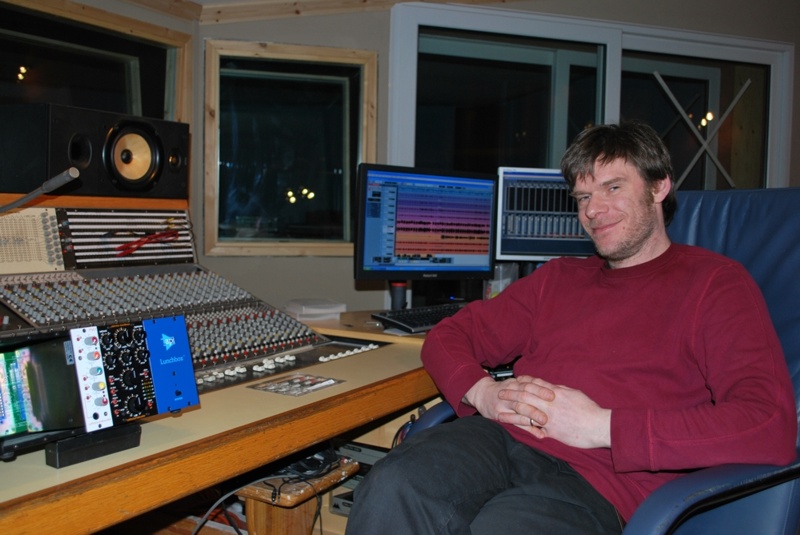
The other thing it does, of course, is compress. As I was expecting, the new Stereo Toolbox sounds great, a bit warmer than the Dynamics Toolbox. It induced in me the desire to turn things all the way up to find out what you can do to colour the sound; talking of which all the knobs are a pleasure to operate, smooth indented pots with metal knobs, it all feels solid. Nice toggle switches too.
I discovered an option on the rear of the unit to select between high and low colour which, according to Robert Campbell the unit's designer, changes the way the output transformers are driven. I left it set to high!
The whole unit takes up just 2 spaces in the API lunchbox and is a smart black with orange and white lettering.
I found the unit in mono operation was not as detailed and controllable as the Dynamics Toolbox but still sounded great, less of the high end "air", more mojo.
Stereo linked is great, clear but warm with plenty of scope to get things pumping or just bring things into line without sounding heavily processed.
So where the Stereo Toolbox gets really interesting is when using compression combined with the width control. In a layman's terms (which is my realm) the unit takes the centre signal and puts it through one compressor and the side signal through the other. This opens up some really useful and exciting options; a stereo kit can be either made to sparkle while taming the snare, or the kick bought forward. On a stereo track it is possible to move a vocal very effectively. I certainly have a client or two who will benefit from that. I also have a suspicion that this way of treating stereo signals is going to get more and more popular when everyone realises just what an amazingly versatile tool it is.
To sum up, this isn't going to take the place of my Dynamics Toolbox, or any 1176's there might be lying around the studio, but that’s not the point. It can, and does, do a great job of tracking but where its real strengths lie are in the combination of stereo width and buss compression where there is nothing else like it.
This is a fantastic bit of equipment, the sound and build quality are top end, and I can't think of anything else that does what is does with such class."
Alex Eden is owner and chief engineer of Factory Street Studios in Bradford UK. The complex is one of the largest in Yorkshire and features both live performance and recording studios along with seven large rehearsal rooms, all under one roof. Alex has recently installed a classic Calrec M-Series mixing console which is a real gem. Check out the studio complex at www.factorystreet.co.uk